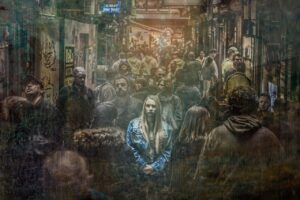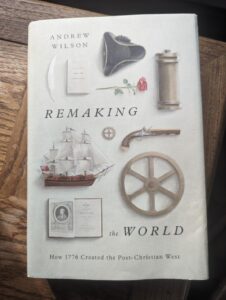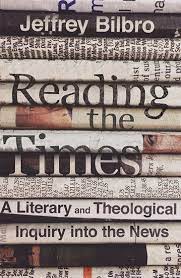All news sources inevitably distort the world because they focus on what is happening today. And that is almost always not of lasting importance or significance. They rarely consider long-term trends and forces the way books do.
Another reason to be skeptical about network news, social media, talk radio, and late-night comics is that they are trying to get attention, capture eyeballs, make money, improve ratings. They are in the entertainment business not the information business. Some don’t pretend to be objective. Even those who do, however, are still shaped by these other major considerations.
In my last post I considered two ways to stop following the news in order to be better informed and better citizens—(1) read books and (2) help people locally. Here are two more.
Third, stop following the news and start making friends.
As I’ve mentioned before in Andy Unedited, liberals and conservatives both agree on a surprising reason our society is so polarized—loneliness. Because we have fewer close relationships, we more easily gravitate to virtual tribes with their extreme outlooks. As David Brooks says,
According to research by Ryan Streeter of the American Enterprise Institute, lonely people are seven times more likely than non-lonely people to say they are active in politics. For people who feel disrespected and unseen, politics is a seductive form of social therapy.
Politics seems to offer a comprehensible moral landscape. We, the children of light, are facing off against them, the children of darkness.
Politics seems to offer a sense of belonging. I am on the barricades with the other members of my tribe.
Politics seems to offer an arena of moral action. To be moral in this world, you don’t have to feed the hungry or sit with the widow. You just have to be liberal or conservative, you just have to feel properly enraged at the people you find contemptible.
Over the past decade, everything has become politicized. Churches, universities, sports, food selection, movie awards shows, late-night comedy—they have all turned into political arenas except this was not politics as it is normally understood.*

David Brooks entire book How to Know a Person is an essential reminder about the seemingly lost art of making conversation and making friends. Joining a local book club, bringing cookies to a new neighbor, talking to other dog owners as you take your pet for a walk—we desperately need to take advantage of these simple opportunities.
Another option is to reconnect with old friends. Think about those you really enjoyed and resonated with, people you haven’t been in contact with for a while. Send an email or text or make a call to renew that valuable relationship. And when you do, don’t talk about the news.
Fourth, stop following the news and start remembering God.
As important as our country is, it is not the most important thing. It could fall apart or democracy could end, and that would be tragic. But our hope is not in our nation. Our hope is in God.
God is our refuge and strength,
an ever-present help in trouble.
Therefore we will not fear, though the earth give way
and the mountains fall into the heart of the sea,
though its waters roar and foam
and the mountains quake with their surging. (Psalm 46:1-3)
When the apostles were beaten and jailed, they did not rail against the government or rage about being under siege by an evil culture. They rejoiced they could suffer for Christ, sang hymns, and talked about Jesus (Acts 5:41-52; 16:19-34).
We may not be in jail, but we also have an opportunity every day to show love, compassion, and tell any who will listen about the real king.
Outwardly it may seem like the world is falling apart, but if we see the world from God’s viewpoint, that puts worry in its place. It means that instead of focusing on the news, we can focus on the two things Jesus said were most important—loving God and loving others.
—
*David Brooks, How to Know a Person, p. 101.
Image: Pixabay



 ♦ Reengage with lifelong friends. Admittedly it can be hard to make new friends. An easier but still very fruitful path might be to renew connections with old friends near and far. In recent years I’ve deliberately increased the emails to, calls and zooms with, and visits to several longstanding friends. Some I’ve had spotty contact with over the years, and some I hadn’t seen in decades. But I’ve so enjoyed the results of more regular connection with all of them.
♦ Reengage with lifelong friends. Admittedly it can be hard to make new friends. An easier but still very fruitful path might be to renew connections with old friends near and far. In recent years I’ve deliberately increased the emails to, calls and zooms with, and visits to several longstanding friends. Some I’ve had spotty contact with over the years, and some I hadn’t seen in decades. But I’ve so enjoyed the results of more regular connection with all of them.  In his book
In his book 
 Wilson closes with three Christian themes from the 1770s to help navigate the weird world that decade has bestowed on us.
Wilson closes with three Christian themes from the 1770s to help navigate the weird world that decade has bestowed on us. Instead of splitting the atom (the fission technology that makes nuclear bombs possible), “
Instead of splitting the atom (the fission technology that makes nuclear bombs possible), “

 What about this: “Scientific models don’t perfectly match observations so they can’t be relied on.” Which FLICC is this? You probably got this right away—it’s impossible expectations which demand unrealistic standards of certainty.
What about this: “Scientific models don’t perfectly match observations so they can’t be relied on.” Which FLICC is this? You probably got this right away—it’s impossible expectations which demand unrealistic standards of certainty.

 In this way Bilbro offers more ways forward than Postman. “Instead of allowing the news to create our communities, Christians should seek to help their communities create the news.” This can begin with the simple act of walking our neighborhoods rather than isolating ourselves in cars or behind screens. On another level we can, for example, pursue redemptive publishing by reading, he suggests, things like Civil Eats, American Conservative, The Atlantic, Commonweal, Hedgehog Review and more.
In this way Bilbro offers more ways forward than Postman. “Instead of allowing the news to create our communities, Christians should seek to help their communities create the news.” This can begin with the simple act of walking our neighborhoods rather than isolating ourselves in cars or behind screens. On another level we can, for example, pursue redemptive publishing by reading, he suggests, things like Civil Eats, American Conservative, The Atlantic, Commonweal, Hedgehog Review and more.